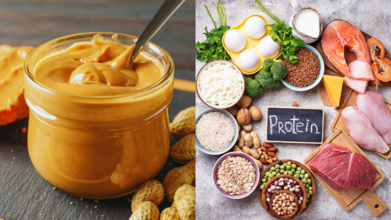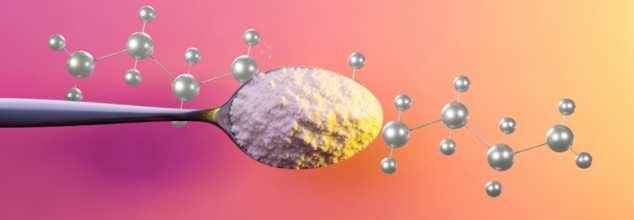- Health Conditions A-Z
- Health & Wellness
- Nutrition
- Fitness
- Health News
- Ayurveda
- Videos
- Medicine A-Z
- Parenting
- Web Stories
This Longevity Vegetable Is Just What You Need for Your Carbs

Credit: Canva
Dan Buettner, longevity expert and founder of Blue Zones, spent his career studying the lifestyles of the planet's eldest inhabitants in order to guide others towards a centenarian life. In a new TikTok video, he put a spotlight on the elusive 'Blue Zone' of Okinawa, Japan, where locals cherish one food that contributes extensively to their lifespan-Sweet Potato.
"Want to live longer? Eat more sweet potatoes."...Forget the latest diet trend - longevity is built on simple, whole foods like this. They are full of complex carbohydrates, they have protein, they are cheap, they taste delicious, they are full of micronutrients," Buettner emphasised.
But Besides Complex Carbs, What Else Does Sweet Potato Offer?
These Tuberous Roots Lower Disease Risk
Sweet potatoes are rich in antioxidants, including beta-carotene, vitamin A, and vitamin E. According to health experts, vitamin E plays a crucial role in reducing cell damage, lowering inflammation, and supporting immune function, all of which contribute to a lower risk of chronic diseases. Additionally, these tubers contain vitamin C, an essential nutrient that strengthens immunity and promotes healthy skin.
They Support Eye Health
Carrots may be famous for supporting vision, but sweet potatoes also offer significant eye health benefits. They contain vitamin A, lutein, zeaxanthin, and beta-carotene, which the body converts into vitamin A. These nutrients work together to help prevent cell damage that could lead to deteriorating eyesight, making sweet potatoes a great choice for maintaining healthy vision.
Packed With Fibre, Great For Digestive Health
Like many fruits and vegetables, sweet potatoes are packed with fibre, which plays a key role in digestive health. They contain both soluble and insoluble fibre, each offering different benefits. Soluble fibre absorbs water in the gut, forming a gel-like substance that improves stool consistency and may help ease diarrhoea. On the other hand, insoluble fibre adds bulk to stool, promoting regular bowel movements and helping to alleviate constipation.
Sweet Potatoes Boost Heart Health
For those looking to improve heart health, sweet potatoes can be an excellent addition to the diet. The fibre in sweet potatoes helps lower LDL (bad) cholesterol, which can reduce the risk of heart disease. Additionally, their fibre content helps regulate blood sugar and combat inflammation, both of which are important for cardiovascular well-being. Furthermore, the antioxidants in sweet potatoes help reduce oxidative stress and protect blood vessels, further supporting heart health.
Choosing the Best Sweet Potatoes
When shopping for sweet potatoes, experts recommend selecting firm ones without bruises or soft spots. Sprouting sweet potatoes should be avoided, as this indicates ageing and potential nutrient degradation.
How to Enjoy Sweet Potatoes?
Sweet potatoes are highly versatile and can be prepared in various ways, just like white potatoes. Popular methods include mashing, baking, roasting, and steaming. They can be incorporated into both savoury and sweet dishes, making them a staple ingredient in many cuisines.
They can be mashed and added to baked goods like bread and pies or used as a base for biscuits, doughnuts, and cakes. Sweet Potato puree serves as a flavorful and nutritious addition to sauces and soups. Blending cooked sweet potato with stock and seasoning with salt, pepper, and spices creates a rich, creamy sauce. Sweet potatoes also work well in hearty soups, adding depth and a naturally sweet flavour. Another method is by roasting. They can be cut into wedges or strips for a healthy alternative to fries.
Why Your Peanut Butter May Not Be the Best Protein Source You Thought It Was

Protein has long been the poster nutrient for muscle-building gym buffs, but the truth is, every body needs it. While carbs and fat have storage lockers in the body, protein does not. That is why a steady intake throughout the day is crucial. And yet, our protein habits are often lopsided—heavier at dinner than at breakfast, when ideally, it should be the other way around.
Your breakfast should be the biggest protein hit of the day, followed by lunch, and then dinner. Why? Because protein helps keep you full and satisfied, which can be great for appetite control, energy, and even weight management.
Protein Does Not Mean Peanut Butter
Peanut butter is often the first thing people grab when trying to “up” their protein game. It is tasty, comforting, and yes, has some protein. But the problem is that those two tablespoons also pack a lot of fat and calories. The real ratio here is not protein-packed but fat-heavy. So while it might be deliciously spreadable, peanut butter is far from being a top-tier protein source.
Is It Healthy? Yes. Is It a Protein Star? Not Really
Peanut butter is not junk food. It contains fibre, vitamins, minerals, and those coveted heart-healthy unsaturated fats. But calling it a protein powerhouse is, well, generous. According to Dr. Jose Antonio, professor of health and human performance at Nova Southeastern University and a co-author of a recent sports nutrition journal report, peanut butter should be thought of as a fat source first. "If you read the nutrition label on any jar of peanut butter, you will see that it is mostly fat. The fat is good for you. But do not fool yourself into thinking that you are getting a lot of high-quality protein," he tells The Washington Post.
What the Research Really Says
A study has warned against the assumption that peanut butter is a go-to for serious protein intake. Compared to other foods like eggs, Greek yoghurt, chicken, beans or fish, peanut butter falls short in the protein stakes while being energy dense, that is, high in calories and fat. The concern is not just about mislabelling but also about unintended consequences. Overdoing peanut butter in an attempt to get more protein might just lead to unintentional weight gain.
What Should You Do?
The message here is not to stop consuming peanut butter. Far from it. It still deserves a spot in your diet but just not as your main protein source. Think of it more like a healthy fat that happens to have a bit of protein, rather than a protein supplement that happens to be tasty.
Use it wisely: a dollop on wholegrain toast, a spoon in your smoothie, or as part of a post-workout snack with a protein-rich food like Greek yoghurt or boiled eggs.
Know What is On Your Plate
Just because a food is labelled "high protein" does not mean it should be your main source. Peanut butter is satisfying, nutritious, and a good addition to your meals, but it is not going to help you hit those protein goals alone.
Intermittent Energy Restriction: How Just Two Days Of Calorie Cuts A Week Can Transform Diabetes Management?

Credits: Health and me
Living with type 2 diabetes often means navigating a maze of diet advice, lifestyle shifts, and blood sugar checks. For those also dealing with obesity, the pressure to find an effective, sustainable eating plan can feel relentless. But what if the solution doesn’t require daily restrictions or extreme fasting windows?
A growing body of research is pointing to intermittent energy restriction (IER)—a strategy that involves eating normally most days and cutting calories just two days a week—as a smarter, more flexible option. Unlike traditional diets that demand constant vigilance, IER appears to offer powerful metabolic benefits with less burnout. In a new clinical trial, it even outperformed other popular methods like time-restricted eating and continuous calorie restriction in improving blood sugar levels, insulin sensitivity, and adherence.
Managing type 2 diabetes and obesity is often a juggling act—between diet, medication, and daily discipline. But what if the answer wasn’t eating less every day, but just twice a week? A growing body of research is pointing to intermittent energy restriction (IER) as a sustainable and effective dietary strategy. And new findings presented at the Endocrine Society’s 2025 meeting are adding weight to the argument.
What Is Intermittent Energy Restriction?
IER is a structured eating pattern where individuals dramatically reduce their calorie intake on just two non-consecutive days per week, while eating normally the rest of the time. It’s not fasting. You still eat—just much less. And unlike time-restricted eating (TRE), you’re not limited by hours in the day.
The most common format is 5:2 IER—five days of normal eating and two days of around 500–600 calories. On non-restricted days, the goal is to eat balanced meals without bingeing. In a randomized 16-week trial, 90 obese adults with type 2 diabetes were split into three groups:
- IER (5:2 calorie restriction)
- Time-Restricted Eating (10-hour eating window daily)
- Continuous Energy Restriction (consistent daily calorie cuts)
All participants consumed the same weekly calories. But the IER group saw the best results across multiple markers:
- Significant reduction in HbA1c (a long-term blood sugar marker)
- Lower fasting glucose and triglycerides
- Improved insulin sensitivity via the Matsuda index
- Highest adherence rate among all groups
Out of 90 participants, 63 completed the trial, with an average age of 36.8 and a BMI of 31.7 kg/m². Most had lived with diabetes for less than two years. People with diabetes and obesity often struggle with long-term adherence to rigid diets. The flexibility of IER may be the game-changer. You’re not depriving yourself daily—and yet, you’re seeing meaningful metabolic changes.
According to Dr. Haohao Zhang, the study’s lead investigator from Zhengzhou University, “These results provide scientific guidance for clinicians to choose effective and sustainable diet plans for patients with obesity and type 2 diabetes.”
Intermittent Energy Restriction vs Intermittent Fasting: Which is Better?
IER is different from traditional intermittent fasting (like the 16:8 or alternate-day fasting) in one crucial way: it doesn’t involve complete fasting. Instead, it focuses on structured calorie reduction, which makes it more accessible for people with diabetes who need blood sugar stability.
Another meta-analysis of 99 clinical trials found that while alternate-day fasting showed modest weight benefits, IER had the best adherence and metabolic improvements in real-world settings.
How to Start Intermittent Energy Restriction?
If you’re managing diabetes or obesity (or both), and you’re curious about IER, here’s how to start:
- Choose two non-consecutive days per week to restrict calories to ~500–600 kcal.
- On those days, focus on high-fiber, low-carb, and protein-rich meals.
- Avoid sugary drinks, refined carbs, and high-fat processed foods.
- Track blood sugar levels regularly, especially in the beginning.
- Talk to your doctor or dietitian—especially if you're on insulin or medications.
Example meal on an IER day:
Breakfast: Boiled eggs with sautéed spinach
Lunch: Grilled chicken breast with steamed broccoli
Snack: A handful of almonds or Greek yogurt
IER is not just effective—it’s also realistic. In the study, adherence was 85% in the IER group, compared to 78% in the TRE group. That matters in the real world, where life, social obligations, and work can derail rigid food plans.
And with no major safety concerns (only mild hypoglycemia reported in a few cases), it’s emerging as a low-risk, high-reward strategy.
While these short-term results are promising, researchers stress the need for longer-duration trials (beyond 6 months). They also want to explore how IER performs in older adults, different ethnic groups, and patients with long-standing diabetes.
But for now, experts say IER could be added to the diabetes care toolkit—not as a replacement for traditional plans, but as a more flexible, effective alternative for those who struggle with daily restrictions.
Could Less Really Be More?
We’re in an era where managing chronic conditions like diabetes demands both science and sustainability. And intermittent energy restriction checks both boxes. It allows freedom five days a week, and structured discipline on two—and that’s a balance many patients are looking for. If you’ve tried daily dieting and burned out, this might be the shift your body—and mind—need.
It’s In Cheese, Soy And Semen! This Natural Compound Can Help People Live Longer

Credits: Health and me (representational)
We have been conditioned to believe longevity is a matter of eating better, sleeping more, and getting our steps in. While that still holds true, researchers and biohackers are increasingly turning their attention to lesser-known compounds that might actually influence how long and how well we live.
The answer is spermidine. Yes, the name sounds awkward, and yes, it was first isolated from semen but if you can get past the origin story, the science behind it is turning heads in longevity research circles. From Japanese medical traditions dating back over a millennium to cutting-edge anti-aging routines in Silicon Valley, spermidine is being taken seriously and for good reason.
What Is Spermidine?
Spermidine is a naturally occurring polyamine, a compound found in nearly every cell in your body. It plays a critical role in cell growth, repair, and renewal. Over time, as we age, the body’s natural production of spermidine declines, leading scientists to explore ways to replenish it through food, supplements, or gut microbiota enhancement.
And yes, while semen was the first biological source it was isolated from (hence the name), spermidine is found in many places: mushrooms, broccoli, aged cheese, breast milk, and even fermented soybeans.
Connection Between Longevity and Sexual Energy
Centuries before spermidine had a name, Eastern traditions were tapping into its potential. In the 28th scroll of Ishinhō — one of Japan’s oldest medical texts — there are specific longevity practices linked to preserving jingqi (life force), emphasizing sexual energy and non-ejaculatory arousal for men. While the text didn’t mention spermidine, the biological rationale seems to track. Now, scientists believe that higher levels of this compound in semen and breast milk may play a part in growth, repair, and immune regulation.
What Can Spermidine Actually Do?
While human trials are still in early stages, preclinical and observational research has shown potential in a number of areas:
Anti-Aging at the Cellular Level
One of the most exciting findings is spermidine’s role in autophagy, a process where cells clean out damaged components to regenerate newer, healthier ones. This mechanism is vital for slowing aging and preventing chronic diseases. Animal studies have shown that spermidine supplementation extended lifespan in mice, yeast, and even worms.
For humans, the jury is still out, but that hasn’t stopped biohackers and longevity enthusiasts — like tech entrepreneur Bryan Johnson — from incorporating spermidine into their daily anti-aging regimens alongside plasma therapy and micronutrient stacks.
Heart Health and Longevity
A 2018 study found that spermidine could improve heart function in mice and extend their lifespan. Even more compelling: a population study involving more than 2,500 participants found that higher spermidine intake was associated with reduced cardiovascular mortality.
These heart benefits are believed to stem from spermidine’s ability to reduce inflammation and improve mitochondrial function — both critical for aging hearts.
Fertility and Reproduction
Although the connection between spermidine and reproduction isn’t surprising given its original source, it’s now being studied more seriously. One trial found that middle-aged mice given high doses of spermidine had improved fertility outcomes — faster egg maturation and larger litters.
There’s growing speculation that spermidine might enhance reproductive longevity in humans, particularly for women looking to extend fertility windows.
Brain Function and Cognitive Health
Cognitive decline is one of aging’s most distressing effects. A 2020 study found that spermidine consumption protected rodents from age-related brain deterioration, including memory lapses and motor impairment.
Scientists are hopeful that these findings can eventually translate into dietary interventions or supplements that may help stave off neurodegenerative conditions like Alzheimer’s or Parkinson’s in humans.
Immunity and Inflammation
Chronic inflammation is a common denominator across many diseases. Because spermidine encourages autophagy and cellular cleanup, researchers believe it could support immune function and help the body respond better to infections or injury — particularly as we age.
Why the Gut Microbiome is Important For Long Life?
Interestingly, your body doesn’t just get spermidine from food. It’s also produced by the gut microbiota, the community of bacteria and microorganisms living in your digestive tract but as we age, the microbiome shifts, and production of key polyamines like spermidine declines.
That’s why some supplements (like Primeadine) combine spermidine with prebiotics to stimulate the body's natural production and absorption. It's a multi-pronged approach — one that respects the interplay between food, microbes, and molecular health.
Where You Can Get Spermidine Naturally?
You don’t have to pop a pill to boost your spermidine levels. It’s found in:
- Soybeans and fermented soy products (especially natto, a traditional Japanese dish)
- Aged cheese
- Mushrooms (like shiitake)
- Spinach and broccoli
- Cauliflower and fresh green pepper
- Amaranth grain
- Pumpkin and grapefruit
Of all these, natto contains the highest spermidine levels — though it’s not the most accessible or palatable option for everyone. For those who prefer to avoid its gooey texture and intense smell, spermidine supplements derived from wheat germ or fermented soy may be a better bet.
Is It Safe?
Here’s the reassuring part: Clinical trials so far show that spermidine supplements are generally safe, with no known side effects. Because it’s a compound your body already produces, it’s well-tolerated. However, long-term effects in humans haven’t been fully studied yet, so moderation and medical consultation are still wise.
The idea that a compound first discovered in semen could help people live longer might sound like something out of a biohacking satire — but the science behind spermidine is growing rapidly. From cellular recycling to heart health and fertility, it shows real promise as a multifunctional longevity aid.
Still, this isn’t a miracle fix. No supplement can replace the fundamentals: movement, real food, sleep, connection. But as we learn more about how our cells age and how we might intervene, spermidine could well become part of the broader toolbox for healthier, longer living.
Whether you're experimenting with fermented soy or considering supplements, the goal remains the same — to live longer, better, and with more vitality. And if a little-known polyamine can help get us there, awkward name or not, it’s worth paying attention to.
© 2024 Bennett, Coleman & Company Limited

